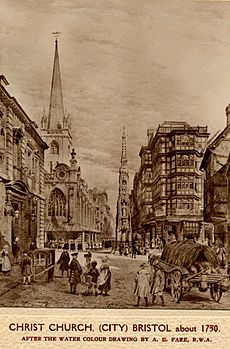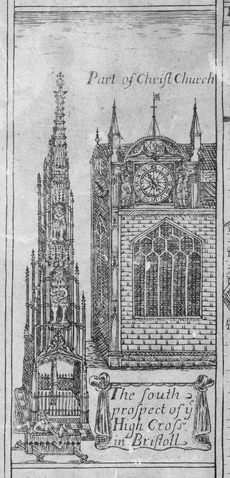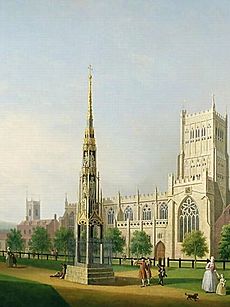Bristol High Cross facts for kids
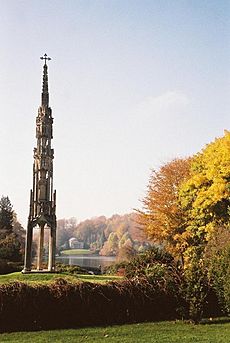
The Bristol High Cross was a tall, fancy stone monument built in 1373 in the middle of Bristol. It looked like a beautiful Gothic tower. It was placed where an older Anglo-Saxon cross used to be. This cross was built to celebrate a special event: King Edward III had given Bristol a special paper (a charter) that made it its own separate area, like a county, no longer part of Somerset and Gloucestershire. The cross was later moved to the Stourhead Estate in 1765, where it still stands today.
Contents
What the Bristol High Cross Looked Like
The cross stood right in the heart of Bristol, where four main streets met. Its base was made of four eight-sided pillars with curved arches. Above this, there were small spaces (called alcoves) that held statues of English kings and queens. At the very top, there was a pointed spire with the actual cross on it.
The cross was made from a type of stone called oolitic limestone. Because this stone could be damaged by frost, the cross was painted in bright colors like blue, gold, red, and a deep red called vermilion. The vermilion was used a lot for the statues' clothes and kept its color well over time.
In 1663, the cross was made even taller! A third level was added to hold four more statues. This meant there were eight statues in total. They faced different streets:
- North, towards Broad Street: King John and King Charles I
- East, towards Wine Street: King Henry III and King Henry VI
- West, towards Corn Street: King Edward III and Queen Elizabeth I
- South, towards High Street: King Edward IV and King James I
Important Events at the Cross
Because the cross was in the very center of Bristol, it became the natural place for many important public events.
In 1399, after a short fight in Bristol, some supporters of King Richard II faced consequences at the cross. The next year, another person, Thomas le Despenser, 1st Earl of Gloucester, also faced consequences there for his part in a rebellion against King Henry IV.
The cross also saw many happy and important announcements:
- In 1487, King Henry VII was welcomed with ceremonies when he visited the city.
- In 1542, Bristol was officially declared a bishopric (meaning it had its own bishop and cathedral) at the cross.
- In 1554, Queen Mary and King Philip were announced as the joint rulers of England there.
- In 1603, James I was announced as the new King of England by city leaders right at the cross.
The area around the cross was also used for public punishments, like the city stocks or pillory, where people who broke rules might be put on display.
Moving the Cross Around
As Bristol grew and became busier, the High Cross started to get in the way of traffic. In 1733, a silversmith who lived nearby complained that the cross was a danger in strong winds. So, the city leaders decided to take it down. The pieces were stored away.
However, in 1736, some citizens arranged for the cross to be put back up. This time, it was moved to College Green, next to Bristol Cathedral. People admired it there as an interesting old monument.
But after only about 30 years, it was seen as an obstruction again! This time, the complaints came from visitors who liked to walk on College Green. The cross made it hard for large groups of people to walk side-by-side. So, in 1762, the cross was taken down again and stored in the cathedral's cloister.
In 1764, the Dean of the cathedral gave the cross to a wealthy man named Henry "the Magnificent" Hoare. The parts of the cross, except for the very worn lower columns, were taken to his grand estate called Stourhead in Wiltshire. The Bristol High Cross is still there today, looked after by the National Trust.
A New Copy of the Cross
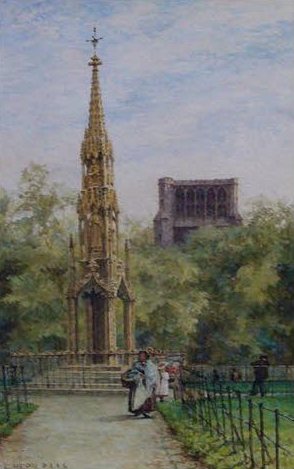 In the Victorian era, people in Bristol wanted their cross back. But the original was too old and fragile to be moved again. So, in 1851, they asked an architect named John Norton to build a copy. This replica would stand on College Green once more.
In the Victorian era, people in Bristol wanted their cross back. But the original was too old and fragile to be moved again. So, in 1851, they asked an architect named John Norton to build a copy. This replica would stand on College Green once more.
Norton carefully studied the original cross to make sure his copy was just right. He hired a famous stone carver, John Thomas, to build the main part of the cross. At first, only one statue was finished—King Edward III. So, the replica stood for many years with empty spaces for the other statues. The rest of the statues were finally added in 1889. The cross was also moved slightly on College Green to make space for a statue of Queen Victoria.
The replica cross was taken down in 1950 when College Green was changed. The upper part of the replica was then moved to nearby Berkeley Square around 1956.
The Statues Today
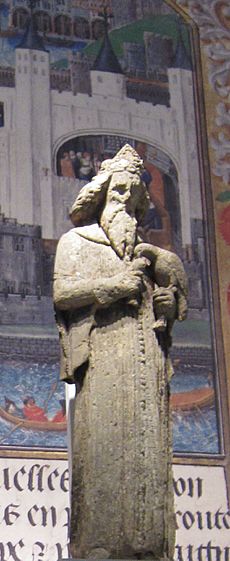
Four of the original statues from the Bristol High Cross at Stourhead were replaced with copies in 1980. The original statues were then loaned to the Victoria and Albert Museum in London, where they can be seen today.
Images for kids


